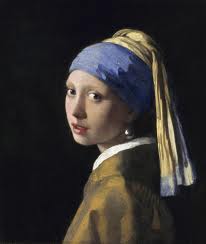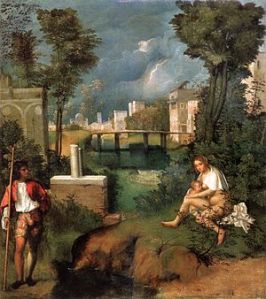THE GIRL WITH A PEARL EARRING by Johannes Vermeer
“To love beauty is to see light.”
Victor Hugo

Johannes Vermeer, The Girl with a Pearl Earring, c.1665, Oil on canvas, 44.5cm×39cm, The Hague
“I was paralyzed, I couldn’t move or talk. I knew at that moment She is leaving my life forever, my brain was screaming at me to do something but I just stand there speechless. My mother and father were standing behind me with their indifferent expressions watching them leave. She was escorted towards the door, her arm tightly gripped by her obese guardian’s fingers. When they reached the door, She turned her head to look at me and I could see all the pain and longing in her face, asking me with her eyes to save her. But I was a young man then and a coward no matter how much I try to tell myself I had no other choice. I can never forget that look, the look that will come to haunt me for the years to come and will continue to haunt me till the day I die. Even my father must have felt it, because he touched my shoulder and squeezed it lightly. The only time this cold society man showed me any affection, ever since I could remember. And then the guardian pulled her softly and they were gone. I remember I kept standing there for a long time looking at the closed door.
Many times I was thinking of painting her, but the pain was too strong and I felt my skill not worthy enough to capture her beauty. But now almost twenty years later, her image is following me not only in my dreams anymore but every time i close my eyes, distracting me from my work and my family. And I know if I don’t paint her I will loose my mind so I stand here in front of the empty canvas, closing my eyes to evoke her face and start crying and paint…”
This is my response to the challenge published in The Guardian asking to imagine a story behind the painting of Johannes Vermeer. Follow the link to see 25 stories chosen by The Guardian. http://www.guardian.co.uk/artanddesign/interactive/2013/feb/01/vermeer-girl-with-pearl-earring-your-stories
Often called the Mona Lisa of the North, “The Girl with a Pearl Earring” by Johannes Vermeer is surrounded by mystery same as Leonardo’s masterpiece. It is an absolutely fascinating portrait of a girl looking at you over her shoulder , with her electrifying gaze. Her look transcendence time and connects you with her on an emotional level through the 400 years that are between you. Her eyes are the focal point of the painting, they giving her an innocent yet sensual expression, the sensuality underlined by the slightly parted lips. It is amazing how such a simple portrait can raise so many questions. Who was that girl? Why is she wearing a turban? What was her relationship with the artist? We know very little about the artist himself, and we can only guess who the subject was. It inspired many polemics, some suggesting it was his eldest daughter, but judging by the sensual expression, this interpretation seems unlikely. Tracy Chevalier, inspired by this mystery, wrote a book with a fictional story behind the painting, which was recently made in a movie.“Within three days I had the whole story worked out. It was effortless; I could see all the drama and conflict in the look on her face. Vermeer had done my work for me. “[1]
watch her TED Talk here (http://www.ted.com/talks/tracy_chevalier_finding_the_story_inside_the_painting.html)
Yet another interesting fact is that Vermeer might have used camera obscura, a precursor of modern photographic camera, to create the painting. This was suggested already 100 years ago, and since then many scholars have tried to solve this mystery. This hypothesis has been recently corroborated by Phillip Steadman’s in-depth study of Vermeer and the camera obscura. Steadman has produced convincing evidence that Vermeer not only employed the camera obscura as an aid to composition but may have used it to trace the projected camera.
http://vermeer0708.wordpress.com/2008/06/02/vermeers-camera-by-philip-steadman/
But no matter what technique Vermeer used, he created an absolute masterpiece. And the fact we know so little about him or his subject only adds to the fascination. The more I look at the painting, the more I am falling for her. Falling in love with a girl dead for centuries, experiencing the power of Art.
[1] “Inspiration.” Girl With a Pearl Earring. N.p., n.d. Web. 17 Apr. 2013.
